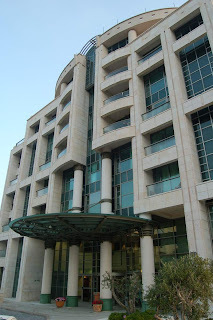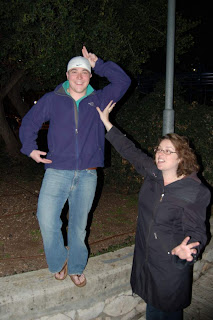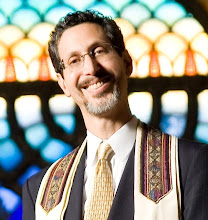(submitted by Sydney Baer)
It was another glorious day that began with a leisurely Israeli breakfast. Because it hasn’t been described as other than vast, that doesn’t do it justice. Breakfast is a huge buffet, there are usually several types of bread, marmalades, granola, yogurt, dried fruit, herring and smoked fishes, a dozen or more types of cheese, Israeli salads, eggs, blintzes, sweets – the best chocolate babka, sweet rolls and cakes and lots of luscious fresh fruit. About 10:30 Zipora, one of the hostesses from the previous evening had had a display of her paper cuts at the synagogue brought over a sampling for Carol to look at to bring back for our Gift Shop. This woman, as all of our hosts and hostesses has remarkable stories.
At noon we board ed our bus that took us to Caesarea, originally a town built by King Herod as a port and beach palace on the Mediterranean. The ruins are extensive and have been carefully excava
ed our bus that took us to Caesarea, originally a town built by King Herod as a port and beach palace on the Mediterranean. The ruins are extensive and have been carefully excava ted and are remarkable for what they show of Roman era life. There was an artificial harbor and a lighthouse associated with the palace and hippodrome. Over th
ted and are remarkable for what they show of Roman era life. There was an artificial harbor and a lighthouse associated with the palace and hippodrome. Over th e years the harbor collapsed, as did the lighthouse and other structures. The main cause was earthquakes. Later, the Crusaders and still later the Ottoman Turks rebuilt structures on the site. The Roman amphitheater has been rebuilt and is still in use. The area of this old city has become an upscale housing area for modern Israelis. That day was very hazy and the pictures reflect it.
e years the harbor collapsed, as did the lighthouse and other structures. The main cause was earthquakes. Later, the Crusaders and still later the Ottoman Turks rebuilt structures on the site. The Roman amphitheater has been rebuilt and is still in use. The area of this old city has become an upscale housing area for modern Israelis. That day was very hazy and the pictures reflect it.
From Caesarea, we boarded the busses for our final stop before heading to the airport. We visited a facility called Pinat Shorashim that is on the kibbutz but not a part of it. Pinat Shorshim’s Exe
to the airport. We visited a facility called Pinat Shorashim that is on the kibbutz but not a part of it. Pinat Shorshim’s Exe cutive Director David Leishman gave us a tour and the history behind this beautiful nature garden and educational center. This kibbutz was established about 30 years ago when David and a group of 20 friends made aliyah. David was originally from New York. He was v
cutive Director David Leishman gave us a tour and the history behind this beautiful nature garden and educational center. This kibbutz was established about 30 years ago when David and a group of 20 friends made aliyah. David was originally from New York. He was v ery articulate and gave us a better understanding of Israeli thinking and social problems. This entire nature preserve has different stations; we first gathered in their sanctuary. The centerpiece of this outdoor sanctuary is the Holy Ark, flanked by the Lions of Judah, with a reproduction of the Gezer Calendar as its background. The Gezer Calendar is the old
ery articulate and gave us a better understanding of Israeli thinking and social problems. This entire nature preserve has different stations; we first gathered in their sanctuary. The centerpiece of this outdoor sanctuary is the Holy Ark, flanked by the Lions of Judah, with a reproduction of the Gezer Calendar as its background. The Gezer Calendar is the old est agricultural calendar ever found, and the earliest known example of Hebrew writing. We then walked to the area near some grape vines where the grapes are smashed. Our next stop was at the beautiful Sukkat Shalom. As we continued the tour, we came upon pomegranate trees, and David stopped to show us the crowns on the pomegranate and the six-pointed stars the crowns form as well as the story behind the 613 seeds in every pomegranate. Pomegranates are on the gates at the entrance. We continued to the Exodus Obstacle Course and wound our way to the Havdalah Garden. David’s wife, Rabbi Miri Gold led our Havdalah service. We plucked the aromatic herbs from the garden as part of our service. Rabbi Gold was the third woman to be ordained as a Rabbi in Israel. Rabbi Gold had visit
est agricultural calendar ever found, and the earliest known example of Hebrew writing. We then walked to the area near some grape vines where the grapes are smashed. Our next stop was at the beautiful Sukkat Shalom. As we continued the tour, we came upon pomegranate trees, and David stopped to show us the crowns on the pomegranate and the six-pointed stars the crowns form as well as the story behind the 613 seeds in every pomegranate. Pomegranates are on the gates at the entrance. We continued to the Exodus Obstacle Course and wound our way to the Havdalah Garden. David’s wife, Rabbi Miri Gold led our Havdalah service. We plucked the aromatic herbs from the garden as part of our service. Rabbi Gold was the third woman to be ordained as a Rabbi in Israel. Rabbi Gold had visit ed Rabbi Cahana at Temple Israel
ed Rabbi Cahana at Temple Israel  in New Rochelle. It was a lovely way to conclude Shabbat in Israel. We then had dinner with Rabbi Miri Gold and David Leishman in the dining hall/tent at Pinat Shorashim. During dinner Rabbi Gold told us that the Israel Religious Action Center has petitioned the State of Israel for the opportunity to her to be recognized as a Rabbi in Israel. At the moment the state only rec
in New Rochelle. It was a lovely way to conclude Shabbat in Israel. We then had dinner with Rabbi Miri Gold and David Leishman in the dining hall/tent at Pinat Shorashim. During dinner Rabbi Gold told us that the Israel Religious Action Center has petitioned the State of Israel for the opportunity to her to be recognized as a Rabbi in Israel. At the moment the state only rec ognizes Orthodox Community Rabbis. The IRAC (Israel Religious Action Center) feels this is discriminatory, as there are many conservative and reform rabbis serving communities in Israel. Rabbi Miri Gold and David were fascinating. They invited us to be a sister congregation. Upon our travels, we learned that many of the congregations in Israel have “sister” congregations in North America.
ognizes Orthodox Community Rabbis. The IRAC (Israel Religious Action Center) feels this is discriminatory, as there are many conservative and reform rabbis serving communities in Israel. Rabbi Miri Gold and David were fascinating. They invited us to be a sister congregation. Upon our travels, we learned that many of the congregations in Israel have “sister” congregations in North America.
Sharon, our tour guide returned to share dinner with us, before boarding the bus for the airport. Sharon bid us farewell about 9:30 p.m. as we prepared four our journey home. There was consensus that it had been a most memorable journey, with very full days and not enough time to do everything. Craig had left our group earlier in the day, and with Rabbi Cahana having left on Thursday evening – 13 of us traveled home. We flew from Tel Aviv to Atlanta. Sharon had provided snacks for our trip and there was an email waiting for us from Sharon as we connected our computers in Atlanta. We all arrived in Portland about noon today – the better for our rich experience in Eretz Israel
It was another glorious day that began with a leisurely Israeli breakfast. Because it hasn’t been described as other than vast, that doesn’t do it justice. Breakfast is a huge buffet, there are usually several types of bread, marmalades, granola, yogurt, dried fruit, herring and smoked fishes, a dozen or more types of cheese, Israeli salads, eggs, blintzes, sweets – the best chocolate babka, sweet rolls and cakes and lots of luscious fresh fruit. About 10:30 Zipora, one of the hostesses from the previous evening had had a display of her paper cuts at the synagogue brought over a sampling for Carol to look at to bring back for our Gift Shop. This woman, as all of our hosts and hostesses has remarkable stories.
At noon we board
 ed our bus that took us to Caesarea, originally a town built by King Herod as a port and beach palace on the Mediterranean. The ruins are extensive and have been carefully excava
ed our bus that took us to Caesarea, originally a town built by King Herod as a port and beach palace on the Mediterranean. The ruins are extensive and have been carefully excava ted and are remarkable for what they show of Roman era life. There was an artificial harbor and a lighthouse associated with the palace and hippodrome. Over th
ted and are remarkable for what they show of Roman era life. There was an artificial harbor and a lighthouse associated with the palace and hippodrome. Over th e years the harbor collapsed, as did the lighthouse and other structures. The main cause was earthquakes. Later, the Crusaders and still later the Ottoman Turks rebuilt structures on the site. The Roman amphitheater has been rebuilt and is still in use. The area of this old city has become an upscale housing area for modern Israelis. That day was very hazy and the pictures reflect it.
e years the harbor collapsed, as did the lighthouse and other structures. The main cause was earthquakes. Later, the Crusaders and still later the Ottoman Turks rebuilt structures on the site. The Roman amphitheater has been rebuilt and is still in use. The area of this old city has become an upscale housing area for modern Israelis. That day was very hazy and the pictures reflect it.From Caesarea, we boarded the busses for our final stop before heading
 to the airport. We visited a facility called Pinat Shorashim that is on the kibbutz but not a part of it. Pinat Shorshim’s Exe
to the airport. We visited a facility called Pinat Shorashim that is on the kibbutz but not a part of it. Pinat Shorshim’s Exe cutive Director David Leishman gave us a tour and the history behind this beautiful nature garden and educational center. This kibbutz was established about 30 years ago when David and a group of 20 friends made aliyah. David was originally from New York. He was v
cutive Director David Leishman gave us a tour and the history behind this beautiful nature garden and educational center. This kibbutz was established about 30 years ago when David and a group of 20 friends made aliyah. David was originally from New York. He was v ery articulate and gave us a better understanding of Israeli thinking and social problems. This entire nature preserve has different stations; we first gathered in their sanctuary. The centerpiece of this outdoor sanctuary is the Holy Ark, flanked by the Lions of Judah, with a reproduction of the Gezer Calendar as its background. The Gezer Calendar is the old
ery articulate and gave us a better understanding of Israeli thinking and social problems. This entire nature preserve has different stations; we first gathered in their sanctuary. The centerpiece of this outdoor sanctuary is the Holy Ark, flanked by the Lions of Judah, with a reproduction of the Gezer Calendar as its background. The Gezer Calendar is the old est agricultural calendar ever found, and the earliest known example of Hebrew writing. We then walked to the area near some grape vines where the grapes are smashed. Our next stop was at the beautiful Sukkat Shalom. As we continued the tour, we came upon pomegranate trees, and David stopped to show us the crowns on the pomegranate and the six-pointed stars the crowns form as well as the story behind the 613 seeds in every pomegranate. Pomegranates are on the gates at the entrance. We continued to the Exodus Obstacle Course and wound our way to the Havdalah Garden. David’s wife, Rabbi Miri Gold led our Havdalah service. We plucked the aromatic herbs from the garden as part of our service. Rabbi Gold was the third woman to be ordained as a Rabbi in Israel. Rabbi Gold had visit
est agricultural calendar ever found, and the earliest known example of Hebrew writing. We then walked to the area near some grape vines where the grapes are smashed. Our next stop was at the beautiful Sukkat Shalom. As we continued the tour, we came upon pomegranate trees, and David stopped to show us the crowns on the pomegranate and the six-pointed stars the crowns form as well as the story behind the 613 seeds in every pomegranate. Pomegranates are on the gates at the entrance. We continued to the Exodus Obstacle Course and wound our way to the Havdalah Garden. David’s wife, Rabbi Miri Gold led our Havdalah service. We plucked the aromatic herbs from the garden as part of our service. Rabbi Gold was the third woman to be ordained as a Rabbi in Israel. Rabbi Gold had visit ed Rabbi Cahana at Temple Israel
ed Rabbi Cahana at Temple Israel  in New Rochelle. It was a lovely way to conclude Shabbat in Israel. We then had dinner with Rabbi Miri Gold and David Leishman in the dining hall/tent at Pinat Shorashim. During dinner Rabbi Gold told us that the Israel Religious Action Center has petitioned the State of Israel for the opportunity to her to be recognized as a Rabbi in Israel. At the moment the state only rec
in New Rochelle. It was a lovely way to conclude Shabbat in Israel. We then had dinner with Rabbi Miri Gold and David Leishman in the dining hall/tent at Pinat Shorashim. During dinner Rabbi Gold told us that the Israel Religious Action Center has petitioned the State of Israel for the opportunity to her to be recognized as a Rabbi in Israel. At the moment the state only rec ognizes Orthodox Community Rabbis. The IRAC (Israel Religious Action Center) feels this is discriminatory, as there are many conservative and reform rabbis serving communities in Israel. Rabbi Miri Gold and David were fascinating. They invited us to be a sister congregation. Upon our travels, we learned that many of the congregations in Israel have “sister” congregations in North America.
ognizes Orthodox Community Rabbis. The IRAC (Israel Religious Action Center) feels this is discriminatory, as there are many conservative and reform rabbis serving communities in Israel. Rabbi Miri Gold and David were fascinating. They invited us to be a sister congregation. Upon our travels, we learned that many of the congregations in Israel have “sister” congregations in North America.Sharon, our tour guide returned to share dinner with us, before boarding the bus for the airport. Sharon bid us farewell about 9:30 p.m. as we prepared four our journey home. There was consensus that it had been a most memorable journey, with very full days and not enough time to do everything. Craig had left our group earlier in the day, and with Rabbi Cahana having left on Thursday evening – 13 of us traveled home. We flew from Tel Aviv to Atlanta. Sharon had provided snacks for our trip and there was an email waiting for us from Sharon as we connected our computers in Atlanta. We all arrived in Portland about noon today – the better for our rich experience in Eretz Israel









































